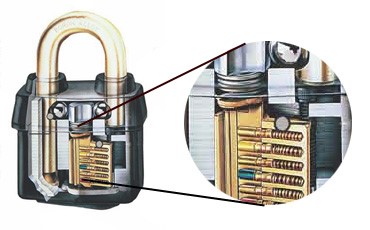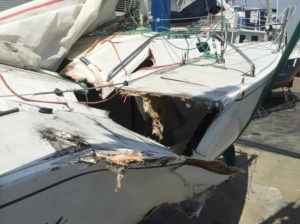Which padlock does my insurance company require?

It is likely you will be asked for one of the following by your insurance company:
- You must have a 5 lever padlock
2. You must have a closed shackle padlock
3. You must have a CEN graded padlock of 3 or more
4. You must have a Sold Secure padlock
It is firstly important to understand that many insurance companies, unfortunately, have been misguided in terms of what specifications to ask for in a padlock.
What if they ask you for a 5 Lever Lock?

This is usually a mistake. Padlocks are rarely made with levers any longer and often insurance companies are confusing the standards for doors locks with padlocks. What they meant to ask for is a “5 pin padlock”. This basically means the lock has at least 5 spring loaded pins which lift up and down depending on the shape of your key. With 5 or more it makes the lock difficult to pick and therefore more secure (see image).
That said, most locks above a reasonable size have 5 pins nowadays and this doesn’t mean they are especially secure. A poorly constructed lock with 5 pins can still be compromised within seconds. If your insurance company specifies this as a requirement we would recommend you still look to get yourself a CEN grade padlock for your own piece of mind. Any lock of CEN quality will have 5 or more pins and tick the box.
Remember that only keyed padlocks can be regarded as “5 pin locks”.
What if they ask you for a Closed Shackle Padlock?
These are padlocks which have built up walls around the shackle and make it difficult for bolt cutters to compromise. The difficulty comes when defining a closed shackle lock since technically both circular discus locks and block-shaped shutter padlocks are also closed shackle in design. Many insurance companies will have a minimum requirement that a padlock used as a security device is of a closed shackle design.
It is important however to remember that by enclosing the shackle it reduces the usable clearance of your padlock. The clearance is the area between the shackles that enable you to lock it through a hole, around a bar or onto a cable. Remember to check the full dimensions before making your decision.
What if they ask you for a CEN Padlock?
These are locks which are tested to specific requirements of European CEN grades. You just need to look for the CEN kitemark on the lock. These kitemarks allow you to be able to easily identify which grade applies to which padlock.
CEN means Central European Norm. It was devised some time ago when the major padlock manufacturers got together to devise a testing standard. Until then it was confusing since there were plenty of standards for door locks and safes but not for padlocks. Some insurance companies tried to use these standards in relation to padlocks but it simply didn’t work. Still today you may get asked for a specification that simply can’t relate to a padlock and only to a safe or door lock.
There are 6 levels within the grade ranging from general use to maximum security. CEN Level 6 padlocks are rare and for more commercial and consumer purposes CEN Level 5 is the highest. We tend to recommend anything between 3-5 for high-security applications.
- GRADE 6 – Maximum Security
- GRADE 5 – Extra High Security
- GRADE 4 – High Security
- GRADE 3 – Medium / High Security
- GRADE 2 – Standard Security
- GRADE 1 – Low Security
The grading system is slightly flawed in that a lock only needs to fail one of the minimum criteria to a single category to be reduced to its lowest scoring grade. This means that some padlocks may perform like a CEN 6 padlock in all tests but fail at minus 40 degree centigrade. It would, therefore, be lowered accordingly. Have a look at some of the tests used in the table below:

The other major issue is that there is no policing of the system. Many manufacturers do not test their locks independently and grade the lock themselves. The only manufacturer that we have found to test their products correctly according to the CEN standards are ABUS.
For its problems, the CEN system is a much better system than simply stating that your padlock must be of a closed shackle design which many insurance companies rely on. There are many open-shackle padlocks that are two grades higher in the CEN system than some of the closed-shackle locks. If you are faced with this problem and that a closed-shackle padlock is simply not convenient, ask your insurance company for a relative CEN Grade.
What if they ask you for a Sold Secure Padlock?
Sold Secure is one of a number of testing standards for locks and padlocks. You will see the name or logo on many bike locks and very occasionally on padlocks. Sometimes your insurance company might specifically ask you for a padlock with a Sold Secure rating of Bronze, Silver or Gold.
The standard was originally set up by the Master Locksmiths Association which informally acts as a governing body for trusted and reputable locksmiths. You either need to look for the Sold Secure logo on the packaging of a product or find a product you like in their catalogue and then go out and source it.
Currently, there are very few padlocks with the rating but ABUS have recently put through all of their ROCK and Extreme ranges of locks which give a nice range of sizes right through the three grades, bronze, silver and gold. Very roughly you can use this as a guide:
- BRONZE: Medium / High security for locking gates, sheds, bicycles etc. Equivalent to the CEN3 insurance grade.
- SILVER: High security with a hardened steel shackle of 11mm or more usually. It will resist attacks well and can be used for motorcycles, larger gates and containers. Equivalent to the CEN4 insurance grade.
- GOLD: Extra high security often with a solid steel body and a shackle of 14mm or more. Many will be of a closed shackle design and be very hard to remove. Ideal for securing vehicles to the ground via a chain, large gates, warehouse doors etc. Equivalent to the CEN4 insurance grade 5 +.
Other standards available?
BS EN 12320 is the UK equivalent and watered downgrading system similar to that of the CEN Grades created by the Association of Building Hardware Manufacturers. It aims to provide the reader with a concise document which includes a summary of relevant sections from the European standard.
Download your original copy here (800kb)
The guide is self-explanatory but if you buy a CEN graded padlock then it will automatically meet the BE EN requirements and more. If however you are simply asked to get a padlock which meets the requirements of BS EN 12320 then you’ll also need to ask which grade. The BSEN grading is identical to that of CEN and was in fact based on CEN.
In theory, a lock which adheres to BS EN 12320 should have two numbers which follow the overall code. for example BS EN 12320-34. The first relates to weather resistance and the latter to security. Since the security rating follows that of CEN then it is easy to understand. The weatherproofing, however, appears to be something that is plucked from thin air and has no real testing factor. They simply state that a lock is suitable for internal or external applications.
A lot of padlocks are BS EN approved but not all are CEN Graded. Most quality padlocks do not state specifically that they adhere to BS EN 12320 but 90% do comply. The question is to what degree and grade. For that, you then need to refer back to CEN.










